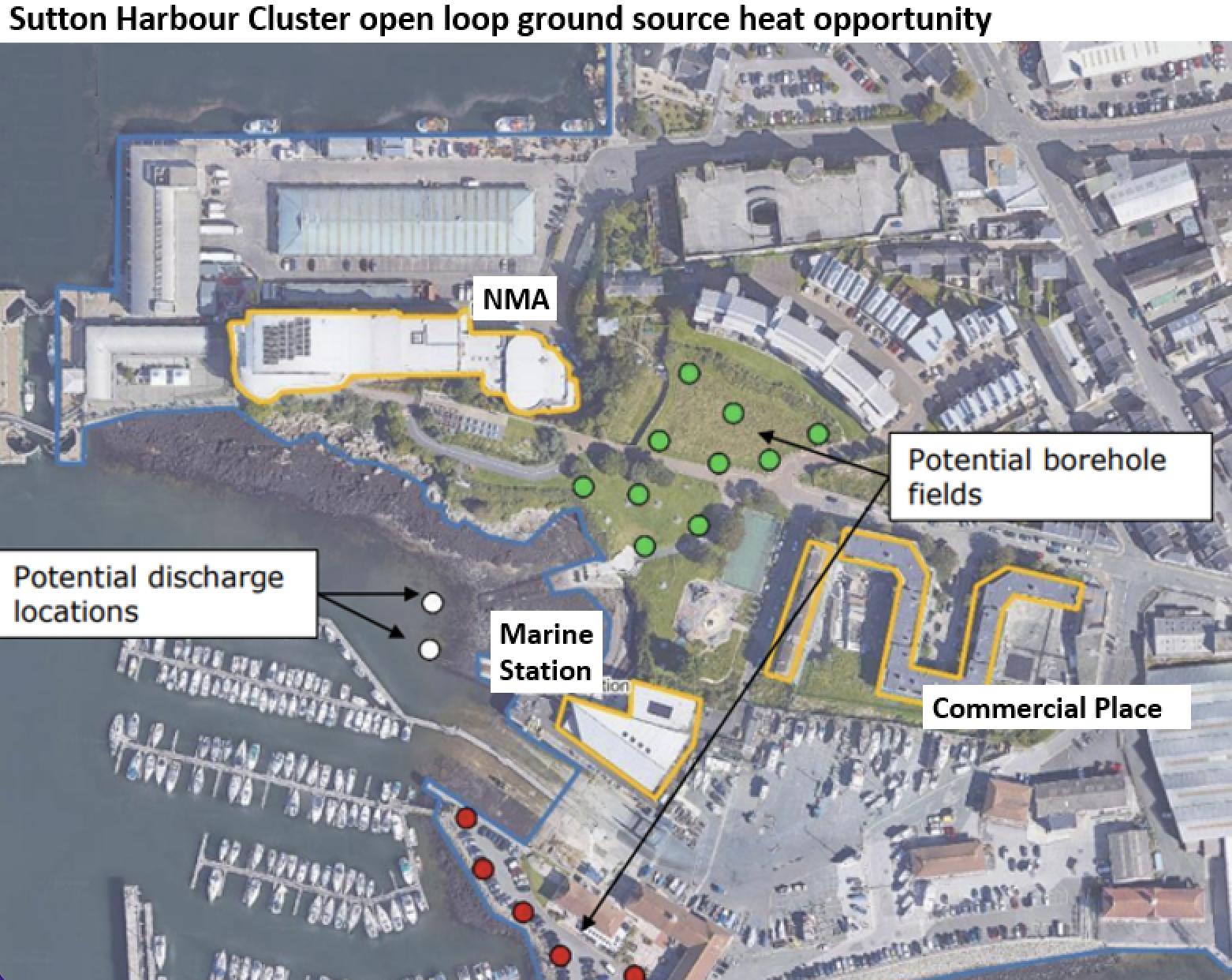
Project Summary
The aim of the project was to determine the most appropriate alternative low-carbon heat source to replace existing natural gas systems for the National Marine Aquarium (NMA) and for other significant heat users nearby, known as the ‘Sutton Harbour Cluster’.
The study assessed the local heat source opportunities, including marine, ground, air and waste, and future connection to the proposed 5G ambient heat network. It then set out a preferred technology and demonstrated the techno-economic feasibility of the preferred option.
Background
The Hub has been supporting Plymouth City Council (PCC) to explore the potential of marine source heat to contribute to the city’s decarbonisation.
The NMA is an important part of the Plymouth economy. It’s a complex site with high heat demand (1.1MW peak), in a waterfront location on Sutton Harbour. PCC have been engaging with the NMA for a number of years about potential decarbonisation.
The Hub previously helped with assessing the feasibility of sourcing heat directly from the harbour. This identified a number of constraints, including impacts on harbour traffic, protected species, ownership rights and the Environment Agency marine consents that would be necessary.
The NMA supplies its tanks with limestone filtered seawater, pumped from a 15-metre borehole through the bedrock. This project tested the hypothesis that boreholes through the limestone could be used for marine source heat, and avoid many of the constraints of pumping directly from the harbour, with the NMA as the main heat load. Significant sites nearby were brought into the project as a Sutton Harbour cluster. These included a large social housing block, and University of Plymouth Marine Station.
In addition, Plymouth is one of 17 cities in the heat network Advanced Zoning Programme, working towards a 5G ambient loop heat network supplying the city centre and university with heat from a South West Water sewage treatment plant. Therefore we also wanted to test the marine source hypothesis against the counterfactual of a future connection to the 5G heat network.
The project aimed to understand the Sutton Harbour cluster connection architecture and demands, from which local heat source opportunities could be assessed, a preferred option identified, and next steps proposed.
Our Role
The Hub developed the project brief with PCC. We then commissioned Buro Happold to undertake the study, and we managed the contract to ensure the aims were met.
Locations
- Sutton Harbour, Plymouth
- National Marine Aquarium
- Plymouth Community Homes ‘Commercial Place’
- University of Plymouth Marine Station
Technology
The project assessed low-carbon heat technologies including: Marine, ground and air-source heat pumps, waste heat recovery and connection to an ambient heat network.
Financing and Ownership
The stakeholders cover the public, private and third sector with different funding mechanisms appropriate to each.
The ambient heat network is to be 100% commercially owned.
This scenario shows a positive 40 year net present value, though funding of approximately 36% of capital expenditure costs would be required to provide an investible 10% internal rate of return.
Results
The project has identified the optimum technical-economic solution for the supply of low carbon heating and cooling to the NMA is to connect to the 5G ambient network.
For Plymouth Community Homes, Commercial Place and University of Plymouth Marine Station, a 4G energy centre, located on council land, would provide the necessary heat upgrade from a connection to the ambient loop.
The outcome is that the final report will be appended to the tender pack for the heat network Advanced Zoning Programme (AZP) Phase 1 commercial partner, being prepared for tender in April.
Benefits
Heat network zoning is based on identifying where heat networks provide the lowest-cost, low carbon heating solution. The project has reinforced this for a complex site such as the NMA.
The project has also progressed understanding of using open loop ground source heat, abstracting seawater from boreholes through the limestone bedrock. This was identified as the secondary option, next to AZP heat network connection.
Next Steps
As well as progressing the AZP tender, further stakeholder engagement is needed with the NMA, which is having to follow a dual approach of also developing its own, stand-alone solutions, due to the critical business risk of end of life equipment as well as the current commercial uncertainties of the AZP network.
Key Facts
| Client | Plymouth City Council |
| Strategic priority | Decarbonisation of heat |
| Energy generation/saving | 1,621kW peak heat, 716kW peak cooling |
| Timeline | The project was completed in November 2024. PCC will tender for the AZP commercial partner in April 2025, with Phase 1 Heat On in 2028. |
| Project value | CAPEX £3.1 million |
| Project report | https://www.swnetzerohub.org.uk/document/plymouth-sutton-harbour-district-heat-network-feasibility-study/ |


